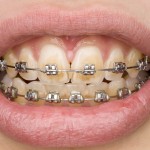
A course of orthodontic treatment typically last 18-24 months. In recent years, a range of surgical and non-surgical approaches have been suggested to reduce the duration of treatment. The aim of this Cochrane review was to assess the effects of surgically assisted orthodontics on the duration and outcome of orthodontic treatment.
Methods
Searches were conducted in The Cochrane Oral Health Group’s Trials Register, The Cochrane Central Register of Controlled Trials (CENTRAL), Medline, Embase, LILACS, metaRegister of Controlled Trials (mRCT), ClinicalTrials.gov, and the World Health Organization International Clinical Trials Registry Platform Search Portal (ICTRP) databases. There were no language restrictions.
Randomised controlled trials (RCTs) evaluating the effect of surgical adjunctive procedures for accelerating tooth movement compared with conventional treatment (no surgical adjunctive procedure) were considered. The primary outcome was the duration of orthodontic treatment, number of visits during active treatment (scheduled and unscheduled) and duration of visits. Where data relating to the overall duration of treatment were not available, the rate of orthodontic tooth movement was recorded. Two reviewers independently selected studies, abstracted data and assessed risk of bias. The Cochrane risk of bias tool was used. The fixed-effect model was used with results expressed as mean differences (MD) with 95% confidence intervals (CI). Heterogeneity was investigated with reference to both clinical and methodological factors.
Results
- 4 studies involving a total of 57 patients were included.
- All 4 studies had an unclear risk of bias.
- Interventions evaluated were corticotomies to facilitate orthodontic space closure or alignment of an ectopic maxillary canine, with the effect of repeated surgical procedures assessed in one of these studies.
- None of the studies reported directly on our primary outcome the main outcome assessed within the trials was the rate of tooth movement, with periodontal effects assessed in one trial and pain assessed in one trial.
- Tooth movement was found to be slightly quicker with surgically assisted orthodontics in comparison with conventional treatment over periods of one month (MD 0.61 mm; 95% CI 0.49 to 0.72; P value < 0.001) and three months (MD 2.03 mm, 95% CI 1.52 to 2.54; P value < 0.001).
- No information on adverse events was reported in the included studies.
Conclusions
The authors concluded: –
This review found that there is limited research concerning the effectiveness of surgical interventions to accelerate orthodontic treatment, with no studies directly assessing our prespecified primary outcome. The available evidence is of low quality, which indicates that further research is likely to change the estimate of the effect. Based on measured outcomes in the short-term, these procedures do appear to show promise as a means of accelerating tooth movement. It is therefore possible that these procedures may prove useful; however, further prospective research comprising assessment of the entirety of treatment with longer follow-up is required to confirm any possible benefit.
Comments
Only a small number of small trials were available to address this question, so the authors note the combined results and conclusions should be interpreted with caution. Most of the studies were also short-term and, in view of the possible adverse effects of surgical approaches, the authors highlight the importance of assessing the outcomes of the full course of treatment, as potential benefits may be minimal over a full course of treatment.
Links
Fleming PS, Fedorowicz Z, Johal A, El-Angbawi A, Pandis N. Surgical adjunctive procedures for accelerating orthodontic treatment. Cochrane Database of Systematic Reviews 2015, Issue 6. Art. No.: CD010572. DOI: 10.1002/14651858.CD010572.pub2.

Little evidence on surgical interventions to accelerate orthodontic treatment. . http://t.co/iy4c3OXkkR
Limited research on effectiveness of surgical interventions to accelerate orthodontic treatment. . http://t.co/iy4c3OXkkR
Little research on surgical interventions to accelerate orthodontic treatment. . http://t.co/iy4c3OXkkR
Few trials to assess effect of surgical interventions to accelerate orthodontic treatment. . http://t.co/iy4c3OXkkR
Don’t miss – Little evidence on surgical interventions to accelerate orthodontic treatment. . http://t.co/iy4c3OXkkR
[…] Dental Elf – 6th Jul 2015 – Orthodontic treatment: limited research on effectiveness of … […]
[…] Dental Elf – 6th Jul 2015 – Orthodontic treatment: limited research on effectiveness of surg… […]